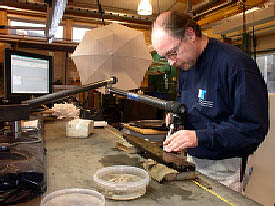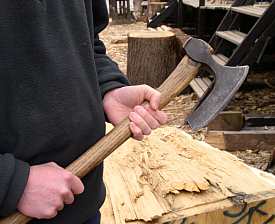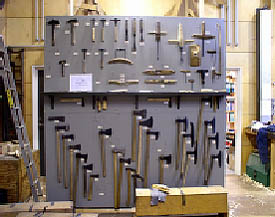|

Ivan Hansen using the laser equipment at the archaeological
laboratory at the Viking Ship Museum in Roskilde Photo:
Michael Borgen
|
Originally, the
Viking Ship Museum was a museum exclusively devoted to the five ships
from Skuldelev, found in Roskilde Fjord - the socalled Skuldelev
ships.
But five years ago, the
museum expanded massively, and next to the Museum building, an
artificial island was made - the Museum Island - housing among other
things the museum shipyard where the Sea Stallion from Glendalough and
other reconstructed Viking
ships were made..
|

A
special axe - in Danish called a Bredbil - is used in building
reconstructed Viking ships even though a specific cut from
this axe has not yet been detected on the labatory yet. But it
is known that this type of axe existed in the Viking age and
was used Photo:
Michael Borgen
|
On
the island is also found the archaeological laboratory, where Ivan
Hansen works. The idea behind the laboratory was, among other things,
to create a place where shipfinds from the entire country could be
measured and analyzed. But while working on the island itself, nine
wrecks were found in the seabed on the very site. Two of the so-called
Roskilde-ships dated from the Viking Age. One was a
longship that, with a total length of 36 meters, was actually longer
than The
Sea Stallion from Glendalough that has now been reconstructed. Since
the finding, Ivan Hansen has mainly been busy analyzing and measuring
the nine ships that were found when his laboratory was built. Today,
the technology is far more refined than it was when the Skuldelev
ships were found in 1962. Back then, the wood was not studied nearly
as thoroughly as it is today.
|

A
wide selection of tools for building the viking ships in
Roskilde Photo:
Michael Borgen
|
Using
laser, Ivan Hansen scans the contours of every single piece of wood on
his computer. Ivan Hansen can recognize the toolmarks and traces of
each particular tool used in the building, and often, he can see
exactly how it was used, too. Regularly
people are called in from the shipyard to see a particularly
interesting axecut, after which the shipbuilders try to copy the cut
on the new longship. Written
and edited by Michael Borgen
Translated from Danish by Kaare Johannesen
|